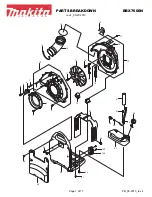
Maintenance— Type 1A1
on the inside portion of the Block Diagram pull-out page.
Exception: If Channel 2 needs to be checked, set the MODE
switch to select Channel 2.
4. Apply a 2V peak to peak calibrator signal through
a T connector and coaxial cables to the Type 1A1 Input
connector of the selected channel and to the test oscillo
scope (item 4 or 5 in Test Equipment list) External Trigger
Input connector.
5. Set the test oscilloscope Input Coupling Switch to AC,
and V/cm switch to 0.5, the Time/cm switch to 0.5 ms, and
the triggering controls for +E xt triggering on the 2 V cali
brator signal.
6
. Touch the test oscilloscope probe tip to the soldered
connection (wired end) of the Input connector center con
ductor for the channel to be checked.
7. Set the test oscilloscope Triggering Level control so
the first half cycle of the waveform is positive going. The
displayed waveform on the test oscilloscope should corre
spond to the waveform polarity and amplitude shown at the
Input connector test point on the CH 1 Input Amplifier dia
gram. Disconnect the probe.
8
. On the diagram locate the next test point where a
waveform is shown. Set the test oscilloscope vertical de
flection factor to correspond to the setting given at the left
side of the diagram waveform.
9. Locate the same test point in the Type 1A1 that cor
responds to the one on the diagram and connect the probe
tip to this test point. Check the displayed waveform ampli
tude and polarity. Disconnect the probe.
10. Repeat steps
8
and 9 until a test point is found where
an abnormal indication is definitely obtained. Then proceed
with detailed troubleshooting checks between that stage and
the preceding test point to isolate the trouble to the small
est possible area until the cause of the trouble is found.
Detailed checks consist of signal tracing the circuits between
the test points to determine where the signal becomes ab
normal. Then voltage and resistance checks may have to be
made; semiconductors (or tube) and other components may
have to be substituted.
Switching Circuit.
To signal trace the Switching Circuit,
use the same technique as described for signal tracing the
signal amplifier stages with the following exceptions:
1. Use a 10-MHz or higher bandwidth test oscilloscope.
2. Use AC input coupling to check the waveform ampli
tude.
3. Use DC input coupling and a suitable vertical deflec
tion factor to check DC levels.
4. Use appropriate + and — Triggering Slope and Source
switch positions for the waveform being checked.
Check Individual Components
The following procedures describe methods of checking
the individual components in the Type 1A1. Components
which are soldered in place can be checked most easily
by disconnecting one end. This eliminates incorrect meas
urements due to the effects of surrounding circuitry.
1. Tube.
The best check of tube operation is actual per
formance under operating conditions. If the tube is suspected
of being defective, it can best be checked by substituting
a new tube or one which has been previously checked.
Turn off the oscilloscope power when substituting the tube.
2. Field Effect Transistors (FET).
Best check is to make
a temporary check by changing with an FET from another
channel known to be good. Turn off the oscilloscope power
when making the exchange. Turn on the oscilloscope and
make the check. After making the check, be sure to return
the FET to its original channel socket and check that it is
properly oriented in the same direction as originally re
moved.
3. Transistors (excluding FET’s).
Defects in transistors
usually take the form of the transistor opening, shorting, or
developing excessive leakage. To check a transistor for
these and other defects, use a transistor curve display in
strument such as a Tektronix Type 575. Flowever, if a good
transistor checker is not readily available, a defective tran
sistor can be found by signal tracing, by making in-circuit
voltage checks, by measuring the transistor forward-to-back
resistance using proper ohmmeter resistance ranges, or by
using the substitution method. The location of all transistors
is shown in the parts location illustrations provided later in
this section.
To check transistors using a voltmeter, measure the emitfer-
to-base and emitter-to-collector voltages. Determine if the
voltages are consistent with the normal resistances and cur
rents in the circuit.
To check a transistor using an ohmmeter, know the ohm-
meter ranges, the currents they deliver, and the internal
battery voltage(s). If the ohmmeter does not have sufficient
resistance in series with its internal voltage source, exces
sive current will flow through the transistor under test. Ex
cessive current and/or high internal source voltage may
damage the transistor.
NOTE
As a general rule, use the R Xlk range where the
current is usually limited to less than 2 mA and
the internal voltage is usually 1.5 V. Current and
voltage can be checked by inserting a multimeter
between the ohmmeter leads and measuring the
current and voltage fo r the range you intend to
use.
When the ohmmeter ranges that will not harm the tran
sistor are known, then those ranges should be used to meas
ure resistances with the ohmmeter connected both ways
as given in Table 5-5.
If there is doubt about whether the transistor is good,
substitute a new transistor; but first, be certain the circuit
voltages applied to the transistor are correct and turn the
oscilloscope power off before making the substitution. If a
transistor is substituted without first checking out the circuit,
the new transistor may immediately be damaged by some
defect in the circuit.
CAUTION
Use care when making measurements in an operat
ing unit. The small size and high density o f com-
5-10
® i
Содержание 1A1
Страница 47: ...Maintenance Type 1A1 670 0075 01 Fig 5 5 Channel 1 Input Amplifier card 5 13 http manoman sqhill com ...
Страница 50: ...Maintenance Type 1AT Fig 5 8 Front of Output Amplifier card 5 16 http manoman sqhill com ...
Страница 128: ...ALT SWEEP SLAVE PULSE CHOPPED BLANKING ALT TRACE SYNC PULSE N 2 0 0 0 0 U P SWITCHING CIRCUIT TYPE IAI PLUG IN ...
Страница 129: ...http manoman sqhill com ...
Страница 130: ...38 ...
Страница 131: ...FIG 3 CIRCUIT CARDS ACCESSORIES CHANNEL I INPUT OUTPUT AMPLIFIER CHANNEL 2 INPUT TYPE 1A1 DUAL TRACE PLUG IN UNIT ...
Страница 134: ...Page 2 o f 2 TYPE 1A1 A p a r t i a l CHAKJKJEL Z INPUT A M P L I F I E R M16 025 1269 ...
















































